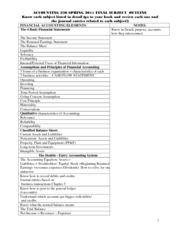Content

Effectively, these numbers “stack” each quarter in order to maintain the comparability of accumulated OCI as best as I can. While the use of accumulated other comprehensive income is required, a privately-held business that does not issue its financial statements to outside parties may elect to avoid its use. If so, and the entity later chooses to have its financial statements audited, the effects of other comprehensive income aoci vs oci should be retroactively made in the audited financial statements. Accumulated other comprehensive income is usually shown below retained earnings — which accumulates net income — in the shareholders’ equity section of the balance sheet. The beginning balance in accumulated other comprehensive income plus the other comprehensive income recorded during the period equals the ending accumulated other comprehensive income.
Is AOCI part of net income?
It is excluded from net income because the gains and losses have not yet been realized.
The flow variable that is both measurable and should be recognized is then added to the list above of items that a reporting entity would include in AOCI. Other comprehensive income is the difference between net income as in the income statement and comprehensive income, and represents the certain gains and losses of the enterprise not recognized in the P&L Account.
What is the difference between OCI and AOCI?
Because OCI has so significantly decreased Comprehensive Income, Shareholder’s Equity doesn’t increase much. This is why, even after a great year of earnings, the balance sheet hasn’t grown nearly as much. However, what’s not clear until we examined OCI is that discussion of the results of operations doesn’t fully disclose the impacts of currency for this business. Pulling up that picture from above again, we see that a large component of the Statement of Comprehensive Income is Foreign currency translation adjustment.
Accumulated Other Comprehensive Income – Investopedia
Accumulated Other Comprehensive Income.
Posted: Fri, 30 Apr 2021 07:00:00 GMT [source]
The loss is measured as the difference between the carrying amount and higher of the present value of the revised expected cash flows, dis- counted at the current market discount rate and the estimated net realizable value of the investment. The tax effects of each component included in OCI, either as part of the stmt presentation or in the notes to the fin stmts. The changes in the accumulated balances of each component of OCI Total AOCI in the B/S as item of equity Reclass adjs. Made to avoid double counting in OCI items displayed in NI for current year. When the gain was originally recorded, it INCREASED stockholder’s equity.
FASB changes format for OCI reclassification reporting
If Halberton followed ASPE, this investment would likely be classified as a short- term trading investment with fair value adjustments at each reporting date, since the investment for shares appears to have active market prices and the investment is for sale . If the shares were not publicly traded, then the investment would likely be classified as an Other Investment – at cost, with no fair value adjustments. If Smythe followed ASPE, then the investment would be accounted for using amortized cost. However, in this case, there would be a choice regarding the method used to amortize the bond premium of $523 calculated in part . The choices are straight-line amortization over the bond’s life or the effective interest rate method shown in part . If the straight-line method was used, then the yearly amortization amount would have been $523 ÷ 10 years or $52.30 per year for 8 years until the bonds were sold in 2028.
Is AOCI a debit or credit?
Accumulated OCI is part of stockholder's equity. So what's the normal balance for stockholder's equity? It's a credit. So credits INCREASE stockholder's equity and debits DECREASE stockholder's equity.
Companies with well-matched investment portfolios and comprehensive hedging may be rewarded with reduced earnings volatility. However, companies may have opted not to hedge interest rate risk due to expensive hedge costs under a low-interest-rate environment.
Reclassification to profit or loss (P&L)
The amortization is also a credit to net periodic pension cost , which means the gain is reducing our expense. If expenses are lower, then net income will be higher, which means that retained earnings will INCREASE. This approach maintains consistency with the offsetting tax effect recognized in net income under the intraperiod allocation requirements of ASC 740. The all-inclusive income concept reports all gains and losses, including those not relating to everyday business operations, on the income statement. Private companies are required to meet the reporting requirements of the amended paragraphs about the roll forward of accumulated OCI for interim and annual reporting periods. But private companies are required to provide information about the impact of reclassifications on line items of net income only for annual reporting periods.

Examples include imports/exports, demand for government debt, fiscal and monetary policy, etc. If we can recognize that foreign currency is playing a big part, we can do more digging to understand why. This is big with insurance companies, who take premiums https://online-accounting.net/ and invest those to make income for their holding company. Note how the company chose to put Unrealized Gains and Losses inside their AOCI calculation, and then adjusted it out of OCI (subtracted $134 as a reclassification away OCI towards Net Income).